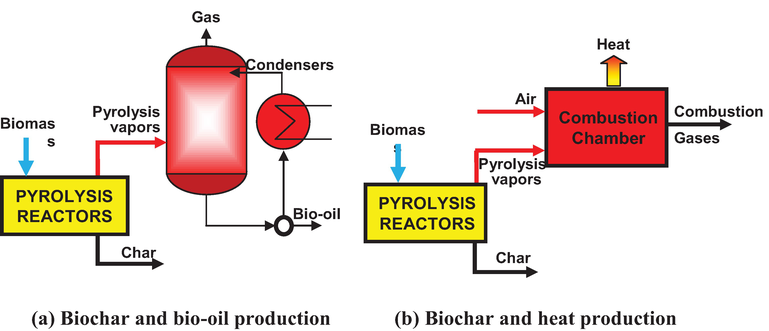
Pyrolysis: A technique to create wealth from wastes
The availability of fossil fuels (petroleum, gas) is limited and they are being exhausted at a very rapid pace. Also, excess use of fossil fuels is creating serious environmental pollution as well. Because of these reasons world is proceeding to explore the renewable sources of energy. It is observed that municipal solid waste (MSW) can be used to generate energy (electricity) via thermal treatment technologies. In general, solid wastes can be categorized as municipal solid waste (MSW), industrial solid waste (ISW) and biomedical solid waste (BSW) on the basis of their genesis. Commonly, MSW include domestic garbage, everyday consumable including packaging, litters, garments, plastics, eatables, newspapers, paint as well as electronic wastes. MSW can be further categorized into biodegradable (e.g. food wastes) and non-biodegradable wastes (e.g. glass, bottles, cans, metals, and certain plastics etc) including some materials which can be recycled, some are hazardous wastes while some are chemical wastes etc. According to the World Bank MSW could be a valuable renewable energy source and by 2025 around 2.2 billon tones of MSW will generated every year globally due to exponential growth of population, number of corporate houses and industrial units. The composition of MSW may differ on the basis of climate, economic growth and geographical conditions of the country. Today MSW pose greater challenges for the under developed or economically weak nations because of their poor infrastructure of waste collection, management, transfer and disposal. On contrary, the scenario is entirely different in developed and developing nations as they have developed some techniques to convert these wastes into useful products like bio-fuels, compost, electricity, heat etc. There are many biological treatment technologies like anaerobic digestion and thermal treatment technologies like gasification, incineration and pyrolysis are reported to convert MSW into useful energy. In this article pyrolysis technique is discussed. Figure 1 shows the block diagram of pyrolysis technique and different products made using this technique.

Fig. 1 Block Diagram on Pyrolysis Technique (Source: [9])
In pyrolysis biomass is treated with high temperature in oxygen limited conditions. The products of pyrolysis could be bio-oil, char along with some gases depending upon the various factors including rate of heating, temperature (300 to 800 0C), particles size of the feedstock as well as residence time. Pyrolysis treatment requires only organic waste so it is necessary that raw waste is segregated into inorganic and organic waste. Gradual rise in temperature up to 8000C may give rise to various types of biological products for instance gases, liquid and solids. The gaseous by-product of pyrolysis treatment of waste is known as syngas which has net calorific value of 15-20 MJ/Nm3 and it contains gases like carbon dioxide, carbon monoxide, hydrogen and methane. Syngas is used in engines, boilers, fuel cells, turbines and heat pumps. Recently, it is also observed that pyrolysis of plastic wastes can produce fuel similar to petrol & diesel. Plasma pyrolysis is the most advance technology advancement in this domain which is capable to generating syngas with high calorific value from plastic wastes. There are many advantages of pyrolysis technique like Easy installation of the equipment, Minimum environmental problems and Different bio-products depending upon raw feedstock etc.
By: Dr. Arun Lal Srivastav, Assistant Professor,
Department of Applied Sciences, Chitkara University, Himachal Pradesh
References
- Eddine, B.T., Salah, M.M. (2012). Solid waste as renewable source of energy: current and future possibility in Algeria. Int J Energ Environ Eng. 3(1): 1-12.
- Sadek, I., Fatiha, S., Aïcha, S., Nouar, M., Amar, C. (2013). Renewable energy potentia l generated by organic waste in Algeria. Int J Renew Energ Res 3(1): 109-113.
- Hamad, T.A., Agll, A.A., Hamad, Y.M., Sheffield, J.W. (2014). Solid waste as renewable source of energy: current and future possibility in Libya, Case Studies Therm Engg. 4, 144-152.
- Gebril, A.O., Omran, A., Pakir, A.H.K., Aziz, H.A. (2010). Municipal solid waste management in Benghazi (LIBYA): current practices and challenges. Environ Eng Manage J. 9(9):1289-1296.
- Moya, D., Aldás, C., López G., Kaparaju, P. (2017). Municipal solid waste as a valuable renewable energy resource: a worldwide opportunity of energy recovery by using Waste-To- Energy Technologies. Energy Procedia. 134, 286-295.
- Trang, P.T.T., Dong, H. Q., Toan, D. Q., Hanh, N. T. X., Thu, N. T. (2017). The Effects of Socio-economic Factors on Household Solid Waste Generation and Composition: A Case Study in Thu Dau Mot, Vietnam. Energy Procedia 107(2), 253-258.
- Agarwal, M., Tardio, J., Venkata Mohan, S. (2013). Critical analysis of pyrolysis process with cellulosic based municipal waste as renewable source in energy and technical perspective. Bioreso. Tech. 147, 361-368.
- Zafar, S. (2014). Overview of Biomass Pyrolysis. Available: http://www.bioenergyconsult.com/tag/biofuels/
- https://www.intechopen.com/books/pyrolysis/pyrolysis-a-sustainable-way-to-generate-energy-from-waste
CLICK HERE to Rate the Article |